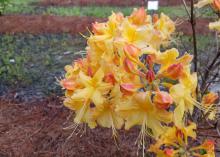Information Possibly Outdated
The information presented on this page was originally released on April 2, 2018. It may not be outdated, but please search our site for more current information. If you plan to quote or reference this information in a publication, please check with the Extension specialist or author before proceeding.
Deciduous azaleas can prosper in full sun
There’s no doubt that spring is here when the Southern indica azaleas start to put on their show.
These showy -- some may even say gaudy -- flowering shrubs seem to just take over our southern landscapes before fading back into an evergreen supporting role for the rest of the year.
But this column is not about the beautiful Southern indica azaleas, which, by the way, are from Asia. This column is about a couple of azaleas native to Mississippi and other southeastern states -- the deciduous azaleas.
Many gardeners are not aware of deciduous azaleas. The main reason is because they are deciduous. They exist as sticks in the landscape through the winter months. For the typical homeowner, they are out of sight, out of mind until they bloom in spectacular fashion in early spring and then fade away again.
The first is commonly called piedmont or honeysuckle azalea, known botanically as Rhododendron canescens. The flowers are beautiful with their various shades of pretty pink and delicate rose with white accents.
As an added treat, these flowers are pleasantly fragrant on a calm, early-morning garden stroll. In my travels around Mississippi during the annual spring horticulture marathon, I always stop and take pictures of these azaleas growing along the woodland edges of the highway.
The second azalea is the Florida flame azalea, Rhododendron austrinum. The flower color range includes yellows, oranges and fiery reds. It’s a treat to drive along the I-10 corridor in the early spring and spot these azaleas growing in their native habitat from Mississippi to Alabama and on through the Florida Panhandle.
When ready, the flower buds swell and the deciduous azalea flowers open on nearly naked stems. The flower buds on the outside of the cluster will open first, followed by those in the middle. The flowers can be up to 1.5 inch across, but it is the stamen and pistil that add charm and interest. These structures extend out of the flower and add a delicate texture to it.
We’ve been growing a nice set of deciduous azaleas from the Sunbow series in the Mississippi State University trial gardens across the state. These deciduous azaleas, as the name suggests, are various shades of yellow, gold and orange. Solar Ray has brilliant yellow flowers with orange shading. Solar Glow flowers are orange-red with yellow highlights that seem to glow in the landscape. And Solar Flare has almost neon yellow flowers with light orange shading. These are part of the Southern Living Plant Collection.
It’s best to plant in a location that has filtered sunlight, as deciduous azaleas evolved along the edges of woodlands. But contrary to the belief that these should be strictly understory plants, many will do quite nicely in full sun. In fact, flower production is usually higher in full sun than in shadier locations. To help with drainage, always plant with the top of the rootball 1 to 2 inches above the soil level.


